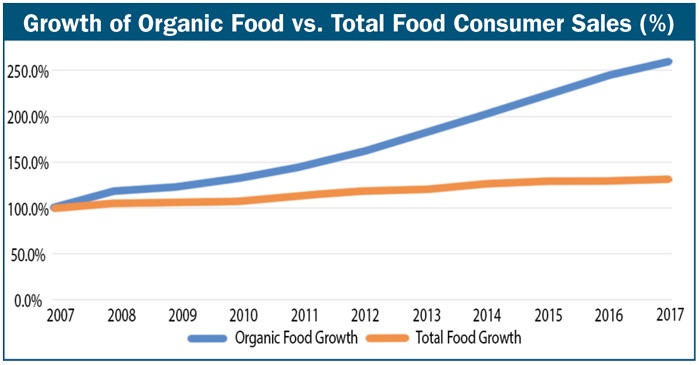Equipment dealers should keep a close eye on organic farming operations in their areas. This segment of agriculture continues to exhibit strong growth patterns, and American consumers increased their purchases of organic products once again in 2017, according to a recent survey from the Organic Trade Assn. While many of the smaller organic farmers often rely on older, used machines, individual operations are growing in size and, at some point, require better equipment.
In mid-May, the business association, in partnership with the Nutrition Business Journal, published the findings of its 2018 Organic Industry Survey. The survey was conducted between Jan. 25 and April 22, and 250 companies participated.
The survey finds that organic sales in the U.S. totaled about $49.4 billion in 2017, an increase of $3.5 billion, or 6.4%, from the previous year. Organic food purchases similarly increased 6.4% to roughly $45.2 billion, also a record year. Total food sales, meanwhile, nudged up 1.1% for the year to nearly $822.2 billion in sales.

Organic foods also continue to increase their penetration into the total food market, now accounting for 5.5% of the food sold in the U.S., compared with 5.2% in 2016 and 3.1% in 2008.
“Our survey shows there are now certified organic products in the marketplace representing all stages of the life cycle of a product or a company — from industry veterans to start-ups,” says Laura Batcha, chief executive officer and executive director of the Organic Trade Assn. “Now we’re able to choose organic in practically every aisle in the store.”
Even with the record breaking year in organic sales, the year-over-year increase is smaller than the gains that organic products saw in 2016 compared with 2015. Sales increased by 9% for that one year span. Association officials say slower growth in the organic dairy and egg category is to blame. Organic egg and dairy grew 0.9% to $6.5 billion.
Fruits and vegetables continue to be the largest organic food category, with a 5.3% growth up to $16.5 billion for 2017. Sales of organic dried beans, along with dried fruits and vegetables, increased by 9%, reflecting growth in demand for legumes and plant-based products.
Historical survey data show organic food has increased at a solid clip reaching back to at least 2008, when sales were around $20.4 billion. Sales have grown by 121.7% between 2008 and 2017.
The year 2013 saw the biggest year-over-year jump within that time period, when the survey recorded a 12.2% increase from 2012. In fact, sales increased by double-digits 4 times between 2008-2017.
Sales of organic non-food products have grown at an even quicker pace from 2008-2017, though it makes up for a tiny share of overall organic sales. Non-food organic sales in 2017 reached nearly $4.2 billion, a 7.4% increase from 2016 and an increase of 151.7% from 2008, according to survey data.
The Organic Industry Survey first measured organic sales in 1997, when sales were pegged at $3.4 million. The 2017 installment of the survey shows a growth in sales of nearly 15 times that of 1997.

Organic food sales have grown at a much faster rate than that of food sales overall. Using 2007 as a "base year," in which both organic food and total food sales are set at 100%, the above chart shows that by 2017, organic food sales have more than doubled, whereas total food sales rose by less than one-third.






Post a comment
Report Abusive Comment